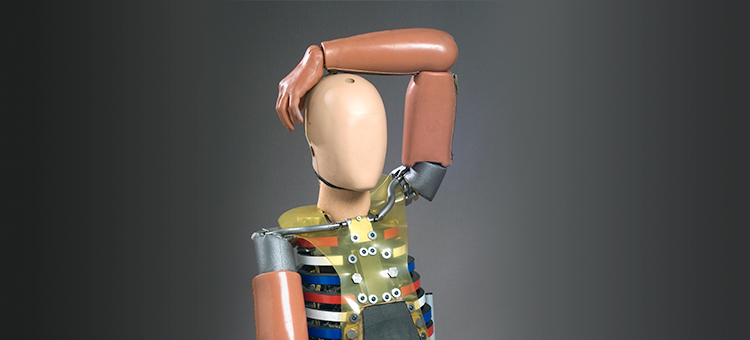New crash test dummy shoulder contributes to safer vehicles
Although standardized crash tests have made car journeys considerably safer over the past 30 years, they have not been totally comprehensive – especially not for oblique frontal collisions. Researchers at Chalmers have developed a crash test dummy that now sets a new, life-saving standard for safety in passenger cars.
Having the misfortune to be in a car accident in a new and modern car is considerably safer compared to 30 years ago. The main driving force behind the increased safety has been the so-called New Car Assessment Programs (NCAP), which set a new standard for crash safety throughout the world. When the tests were launched in the early 1990s, they received a lot of media attention, which lead to more and more investments in safety by car manufacturers. For car manufacturers performing well in the tests became, and continues to be, one of the most important marketing arguments.
For some time, crash safety improved mainly for the types of collisions that were represented in the official crash tests, especially for car companies that previously had a low level of ambition in their safety work. However, the risk of injury was still high in accidents where the body was thrown forward in oblique positions, such as in frontal collisions with oblique force direction. “We wanted to contribute to a new test standard for oblique collisions. The dummy used previously turned out to be too rigid and did not give a fair representation of how an actual person reacts to a crash that throws the body forward obliquely”, says Mats Svensson, professor at the Department of Mechanics and Maritime Sciences.
An important research tool
To find out how a person moves and is affected by the safety belt in a collision, researchers from Chalmers compiled results from earlier studies and supplemented it with own mobility tests of the shoulder part of test subjects. In this way, the researchers could see how a human shoulder moves and compare it with the standard dummy, which was used for crash tests. It then became evident that the greatest shortcoming of the crash dummy was the difference in the more extensive and complex motion range of the human shoulder.
With the support of other partners in SAFER, Volvo Cars and Autoliv, the Chalmers researchers developed an artificial shoulder for the crash dummy that could better mimic the human shoulder’s mobility in interaction with the three-point belt in oblique collisions. The design of the dummy is a key factor in the development and evaluation of new safety belts and airbags.
“The new type of artificial shoulder was an important research tool for us at Volvo Cars, which makes it possible for us to gain a better understanding of the human body's movement and the car's protective function in collisions with oblique forward movements. Our accident follow-up shows that oblique collisions are common in traffic and have significance for the damage outcome”, says Lotta Jakobsson, Research area director at SAFER.
NCAP next step
Chalmers has participated in the further development of the artificial shoulder and the new crash test dummy, which has resulted in that now both Euro NCAP and US NCAP has the ambition to use the new dummy in future standardized collision tests of new cars. Johan Davidsson is an associate professor at the Department of Mechanics and Maritime Sciences has been Chalmers spokesperson in the international forums that evaluated and recommended the new more advanced crash dummy with the new shoulder.
“It is now possible to fine-tune and evaluate airbags and seat belts that use the latest sensor technology to tailor the protection in real-time in the event of a collision. We are convinced that we have contributed to a significant future reduction of injuries and deaths in car collisions”, says Johan Davidsson.

